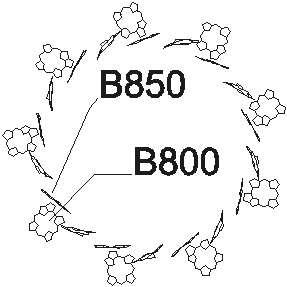EXCITED STATE DYNAMICS IN PHOTOSYNTHETIC LIGHT HARVESTING STUDIED BY FEMTOSECOND SPECTROSCOPY
T. Pullerits
Department of Chemical Physics, Lund University, Box 124, 22100 Lund, Sweden
In densely packed B850 ring of photosynthetic purple bacteria (see Fig. 1.) excited states are delocalized over a number of bacteriochlorophyll (BChl) molecules. Different studies have proposed a large variety of values for the exciton delocalization length in B850 from a BChl dimer to a full ring exciton [1].

Fig. 1. Structure of the LH2 antenna from Rps. acidophila Only BChl molecules are shown. Two rings of pigment molecules are called B800 (outer ring) and B850 (inner ring) according to their main BChl Qy band absorption maxima.
Recently we have studied excitons in LH2 using singlet-singlet annihilation. The new approach has enabled us to address the question of exciton delocalization from an unusual angle which may resolve some of the controversies of exciton delocalization length in B850.
We will also report kinetic studies of the Förster hopping [2], exciton relaxation [3] and polaron formation [4]. Our aim is to develop a consistent physical model of photosynthetic light harvesting capable of explaining all significant features of our femtosecond time-resolved experiments.
[1] V.Sundström, T.Pullerits and R. van Grondelle, J. Phys. Chem. B, 1999, 103, 2327.
[2] J.L. Herek, N. Fraser, T. Pullerits, P. Martinsson, T. Polivka, H. Scheer, R.J. Cogdell, V. Sundström. Biophys. J. 2000, 78, 2590.
[3] T. Pullerits. J. Chinese Chemical Soc.2000, 47, 773.
[4] T. Polivka, T. Pullerits, J.L. Herek, V. Sundström, J. Phys. Chem. B. 2000,
104, 1088.